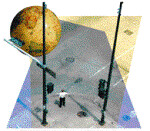Gokura
[The next entry from Michael5000's Forgotten Lands with maps by Cartophiliac.]
Gokura
Capital: Gokura
Population: 542,486 (2000 census)
Economy: Shipping, finance, and light industry dominate an internationally oriented economy. Agricultural production is exclusively for local production. Gokura prints no money of its own; the local merchants and cashiers are willing and uncannily able to accept, calculate a rate for, and make change in virtually any significant world currency.

If the impossibly rugged and remote island of New Guinea is to a certain extent a world of its own, then this prosperous little country occupying the lower valley of the Five Bats River is the least typical part of that world. Where Papua New Guinea is one of the least technologically developed countries on Earth, Gokura is a gleaming oasis of modernity. Where Papua New Guinea is loosely governed by a weak central government, in Gokura the state is deeply involved in the lives of its citizens. Papua New Guinea is overwhelmingly Christian and largely off the beaten track; Gokura is Muslim and, at nearly the eastern tip of the island, sits on a natural bottleneck for oceangoing traffic.

Gokura, converted by traders in missionaries in the 13th Century, represents the easternmost spread of traditional Islam. Held by the Portuguese during the colonial era, it was incorporated into Japan’s military empire in the 1930s, gaining independence after liberation by Australian troops during the Second World War. Though much smaller and of a lower profile than other Asian city-states, it has developed a similar prosperity over the last half-century through success in shipping, manufacturing, financial services, and technology. A rare high-profile moment was a 1998 cover story on “Asia’s Other Tiger” in the business magazine The Economist.
Gokura is a self-avowed Islamic state. Non-observance is tacitly tolerated, but public practice of faiths other than Islam is strictly prohibited. The city and its surrounding farms convey an impression of immaculate order, tidiness, and cleanliness. The government ascribes the extremely low crime rate to a faith-based public education system and strict enforcement of traditional Islamic law.
 Flag: Intersecting green diagonals, trimmed with gold on official banners (but not on the less expensive flags seen on many schools and public buildings), against a black background. No official account of the flag’s design is known, but the green is assumed to have been chosen to represent Islam.
Flag: Intersecting green diagonals, trimmed with gold on official banners (but not on the less expensive flags seen on many schools and public buildings), against a black background. No official account of the flag’s design is known, but the green is assumed to have been chosen to represent Islam.Labels: flags, forgotten lands, imaginary countries





3 Comments:
I never heard of Gokura before today so I'm not expert, but Gokura's striking differences with New Guinea reminds me of the Hong Kong once differed greatly with China in terms of size, location, culture and economics.
I love these Forgotten Lands features.
Gokura. heh.
Actually, the first comparison I thought of was Brunei:
http://en.wikipedia.org/wiki/Brunei
Many striking coincidences, eh? We should talk to Michael about that...
Post a Comment
Subscribe to Post Comments [Atom]
<< Home